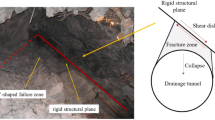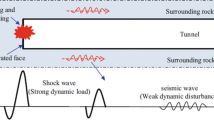Abstract
In the process of geothermal energy development, there is groundwater vapor condensation, and the rock is in an alternating dry and wet environment, so it is of great significance to study the influence of high temperature dry and wet cycle on argillaceous sandstone. In this study, the argillaceous sandstone samples were heated at 200 °C after saturation with water and subjected to 120 drying-wetting cycles to study the damage characteristics of rock under high-temperature drying-wetting cycles. The changes in the damage characteristics of rock samples were monitored by acoustic emission (AE). The results highlighted that during the heating stage, there was a decrease in the continuity of thermal AE signal and an increase in the signal strength with an increase in the number of cycles. During the constant temperature stage, the intensity of the thermal AE signal was weak through 0–40 cycles and subsequently increased significantly with the increase in the number of cycles. There was a gradual increase in the number, length, and width of fractures on the surface of argillaceous sandstone with the increase in the number of cycles. The surface fracture rate increased linearly, reaching 2.8% after 120 cycles, forming a fracture network. According to the changes observed in the saturated water absorption rate, the process of fracture development can be divided into the initiation stage (0–40 cycles), expansion stage (41–80 cycles), and penetration stage (81–120 cycles). Moreover, there was an increase in the saturated water absorption rate and loss of mass in each stage with the increase in the number of cycles. This study can provide a theoretical basis for the development of geothermal resources.













Similar content being viewed by others
References
Brochard L, Honório T, Vandamme M, Bornert M, Peigney M (2017) Nanoscale origin of the thermo-mechanical behavior of clays. Acta Geotech 12(4):1–19. https://doi.org/10.1007/s11440-017-0596-3
Cai X, Zhou Z, Liu K, Du X, Zang H (2019) Water-weakening effects on the mechanical behavior of different rock types: phenomena and mechanisms. Appl Sci 9(20):4450. https://doi.org/10.3390/app9204450
Chen X, Eichhubl P, Olson JE, Dewers TA (2019) Effect of water on fracture mechanical properties of shales. Journal of Geophysical Research: Solid Earth 124(3):2428–2444. https://doi.org/10.1029/2018JB016479
Cherubini Y, Cacace M, Scheck-Wenderoth M, Moeck I, Lewerenz B (2013) Controls on the deep thermal field: implications from 3-D numerical simulations for the geothermal research site Groß Schönebeck. Environmental Earth Sciences 70(8):3619–3642. https://doi.org/10.1007/s12665-013-2519-4
Collins BD, Stock GM (2016) Rockfall triggering by cyclic thermal stressing of exfoliation fractures. Nat Geosci 9(5):395–400. https://doi.org/10.1038/NGEO2686
Collins BD, Stock GM, Eppes MC, Lewis SW, Corbett SC, Smith JB (2018) Thermal influences on spontaneous rock dome exfoliation. Nat Commun 9(1):1–12. https://doi.org/10.1038/s41467-017-02728-1
Dang C, Sui Z, Yang X, Ge Z (2022) Pore changes in purple mudstone based on the analysis of dry-wet cycles using nuclear magnetic resonance. Shock and Vibration. https://doi.org/10.1155/2022/5578401
Doostmohammadi R, Moosavi M, Mutschler T, Osan C (2009) Influence of cyclic wetting and drying on swelling behavior of mudstone in south west of Iran. Environ Geol 58(5):999–1009. https://doi.org/10.1007/s00254-008-1579-3
Du B, Cheng Q, Miao L, Wang J, Bai H (2021) Experimental study on influence of wetting-drying cycle on dynamic fracture and energy dissipation of red-sandstone. J Build Eng 44:102619. https://doi.org/10.1155/2020/6688202
Filipussi DA, Guzmán CA, Xargay HD, Hucailuk C, Torres DN (2015) Study of acoustic emission in a compression test of andesite rock. Procedia Materials Science 9:292–297. https://doi.org/10.1016/j.mspro.2015.04.037
Gautam PK, Verma AK, Maheshwar S, Singh TN (2016) Thermomechanical analysis of different types of sandstone at elevated temperature. Rock Mech Rock Eng 49(5):1985–1993. https://doi.org/10.1007/s00603-015-0797-8
Ge Z, Sun Q, Zhang N (2020) Changes in surface roughness of sandstone after heating and cooling cycles. Arab J Geosci 13(8):1–8. https://doi.org/10.1007/s12517-020-05295-w
Hu B, Cui A, Cui K, Liu Y, Li J (2021) A novel nonlinear creep model based on damage characteristics of mudstone strength parameters. Plos One 16(6):e0253711. https://doi.org/10.1371/journal.pone.0253711
Hu M, Liu Y, Ren J, Wu R, Zhang Y (2019) Laboratory test on crack development in mudstone under the action of dry-wet cycles. Bull Eng Geol Env 78(1):543–556. https://doi.org/10.1007/s10064-017-1080-x
Huang H, Che P (2007) Research on micro-mechanism of softening and argillitization of mudstone. JOURNAL-TONGJI UNIVERSITY 35(7):866. https://doi.org/10.3321/j.issn:0253-374X.2007.07.002
Huang X, Tang SB, Tang CA (2020) Boundary-effect and scale-heating rate equivalence effect of cracking behavior in the rock models subjected to heating from the central borehole. SCIENCE CHINA Technol Sci 63(5):809–818. https://doi.org/10.1007/s11431-019-1441-7
Jia H, Ding S, Zi F, Dong Y, Shen Y (2020) Evolution in sandstone pore structures with freeze-thaw cycling and interpretation of damage mechanisms in saturated porous rocks. Catena 195:104915. https://doi.org/10.1016/j.catena.2020.104915
Li D, Yang G, Lu K, Long D (2020) Study on pore and thermoacoustic emission characteristics of dry and wet cyclic brittle red sandstone. J Guizhou Univ: Nat Sci Ed 37(2):7. https://doi.org/10.15958/j.cnki.gdxbzrb.2020.02.16
Liu X, Jin M, Li D, Zhang L (2017) Strength deterioration of a shaly sandstone under dry–wet cycles: a case study from the Three Gorges Reservoir in China. Bull Eng Geol Env. https://doi.org/10.1007/s10064-017-1107-3
Liu X, Li Y, Li S, Zhou Y (2019) Research on the disintegration characteristics of carbonaceous mudstone and properties of modified materials. Adv Civ Eng. https://doi.org/10.1155/2019/4382054
Liu Z, Yao Q, Kong B, Yin J (2020) Macro-micro mechanical properties of building sandstone under different thermal damage conditions and thermal stability evaluation using acoustic emission technology. Construct Build Mater 246:118485. https://doi.org/10.1016/j.conbuildmat.2020.118485
Ma T, Wei C, Yao C, Yi P (2020) Microstructural evolution of expansive clay during drying–wetting cycle. Acta Geotechnica 15(2–4). https://doi.org/10.1007/s11440-020-00938-4
Meng Y, Jing H, Yin Q, Gu X (2020) Investigation on mechanical and AE characteristics of yellow sandstone undergoing wetting-drying cycles. KSCE J Civ Eng 1–12. https://doi.org/10.1007/s12205-020-0572-6
Nara Y, Yamanaka H, Oe Y, Kaneko K (2013) Influence of temperature and water on subcritical crack growth parameters and long-term strength for igneous rocks. Geophys J Int 193(1):47–60. https://doi.org/10.1093/gji/ggs116
Pin W, Yin T, Hu B (2020) Dynamic tensile strength and failure mechanisms of thermally treated sandstone under dry and water-saturated conditions. Transactions of Nonferrous Metals Society of China 30(8):2217–2238. https://doi.org/10.1016/S1003-6326(20)65374-2
Rybar P (2007) Geothermal energy sources and possibilities of their exploitation. Acta Montanistica Slovaca 12(1, pt. 1):31–41
Siegesmund S, Sousa L, Knell C (2018) Thermal expansion of granitoids. Environ Earth Sci 77(2):41.1–41.29. https://doi.org/10.1007/s12665-017-7119-2
Wang F, Cao P, Cao R, Xiong X, Hao J (2019) The influence of temperature and time on water-rock interactions based on the morphology of rock joint surfaces. Bull Eng Geol Env 78(5):3385–3394. https://doi.org/10.1007/s10064-018-1315-5
Weng L, Wu Z, Liu Q (2019) Influence of heating/cooling cycles on the micro/macrocracking characteristics of Rucheng granite under unconfined compression. Bull Eng Geol Env 79:1289–1309. https://doi.org/10.1007/s10064-019-01638-4
Wong LNY, Maruvanchery V, Liu G (2016) Water effects on rock strength and stiffness degradation. Acta Geotech 11(4):713–737. https://doi.org/10.1007/s11440-015-0407-7
Xin L, Li C, Liu W, Xu M, Xie J, Han L, An M (2021) Change of sandstone microstructure and mineral transformation nearby UCG channel. Fuel Proc Technol 211:106575. https://doi.org/10.1016/j.fuproc.2020.106575
Yang D (2021) Compressional wave propagation in saturated porous media and its numerical analysis using a space–time conservation element and solution element method. Rev Sci Instrum 92(12):125108. https://doi.org/10.1063/5.0064186
Yang J, Mu Z, Yang S (2020) Experimental study of acoustic emission multi-parameter information characterizing rock crack development. Eng Fract Mech 232. https://doi.org/10.1016/j.engfracmech.2020.107045
Yao W, Li C, Zhan H, Zhou J, Criss RE, Xiong S, Jiang X (2020) Multiscale study of physical and mechanical properties of sandstone in three Gorges reservoir region subjected to cyclic wetting–drying of Yangtze river water. Rock Mech Rock Eng 53(5):2215–2231. https://doi.org/10.1007/s00603-019-02037-7
Ying P, Zhu Z, Ren L, Deng S, Niu C, Wan D, Wang F (2020) Deterioration of dynamic fracture characteristics, tensile strength and elastic modulus of tight sandstone under dry-wet cycles. Theor Appl Fract Mech 109:102698. https://doi.org/10.1016/j.tafmec.2020.102698
Zeng L, Liu J, Gao Q, Bian H (2019) Evolution characteristics of the cracks in the completely disintegrated carbonaceous mudstone subjected to cyclic wetting and drying. Adv Civ Eng. https://doi.org/10.1155/2019/1279695
Zhang Z, Liu W, Han L, Chen X, Cui Q, Yao H, Wang Z (2018) Disintegration behavior of strongly weathered purple mudstone in drawdown area of three gorges reservoir, China. Geomorphology 315(AUG.15):68–79. https://doi.org/10.1016/j.geomorph.2018.05.008
Zhao Y, Sun Q, Wang S, Zhang L, Jiang Z (2022) Pore characteristics and permeability changes of high-temperature limestone after rapid cooling by dry ice. Heat Mass Transf 58(8):1339–1352. https://doi.org/10.1007/s00231-021-03171-1
Zhao Z, Yang J, Zhang D, Peng H (2017) Effects of wetting and cyclic wetting–drying on tensile strength of sandstone with a low clay mineral content. Rock Mech Rock Eng 50(2):485–491. https://doi.org/10.1007/s00603-016-1087-9
Zhu D, Jing H, Yin Q, Han G (2018) Experimental study on the damage of granite by acoustic emission after cyclic heating and cooling with circulating water. Processes 6(8):101. https://doi.org/10.3390/pr6080101
Zimmermann G, Reinicke A (2010) Hydraulic stimulation of a deep sandstone reservoir to develop an enhanced geothermal system: laboratory and field experiments. Geothermics 39:70–77. https://doi.org/10.1016/j.geothermics.2009.12.003
Funding
This research was supported by the National Natural Science Foundation of China (Grant No. 41972288).
Author information
Authors and Affiliations
Corresponding author
Ethics declarations
Conflict of interest
The authors declare no competing interests.
Rights and permissions
Springer Nature or its licensor (e.g. a society or other partner) holds exclusive rights to this article under a publishing agreement with the author(s) or other rightsholder(s); author self-archiving of the accepted manuscript version of this article is solely governed by the terms of such publishing agreement and applicable law.
About this article
Cite this article
Wang, J., Sun, Q., Xue, S. et al. Study on the effect of high-temperature dry–wet cycles on argillaceous sandstone. Bull Eng Geol Environ 82, 318 (2023). https://doi.org/10.1007/s10064-023-03320-2
Received:
Accepted:
Published:
DOI: https://doi.org/10.1007/s10064-023-03320-2




